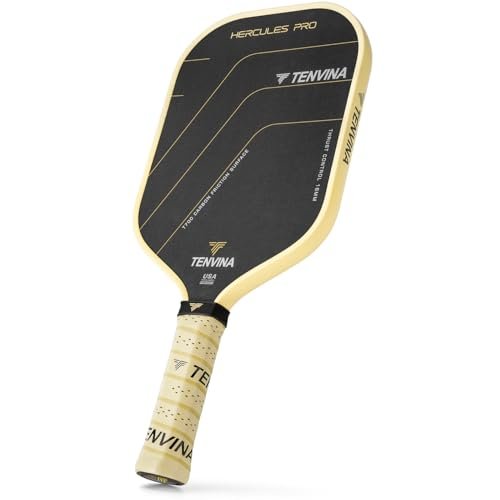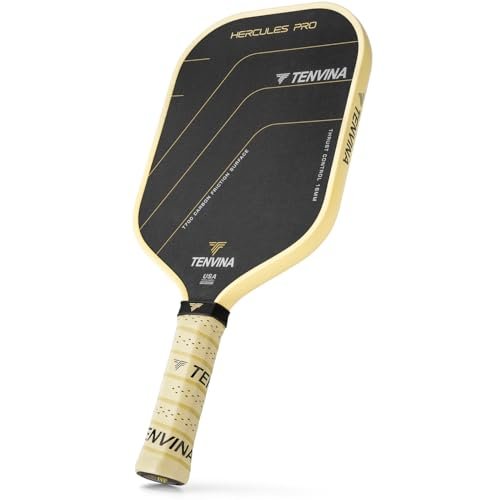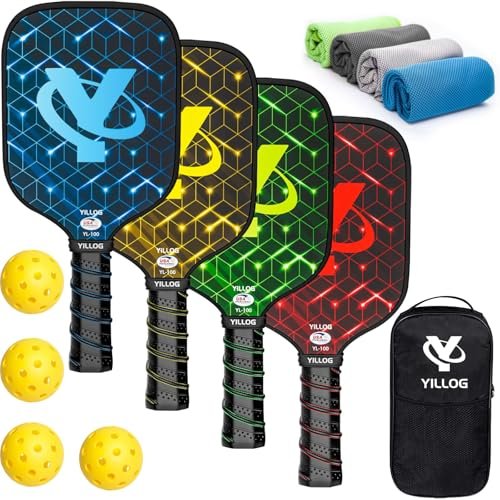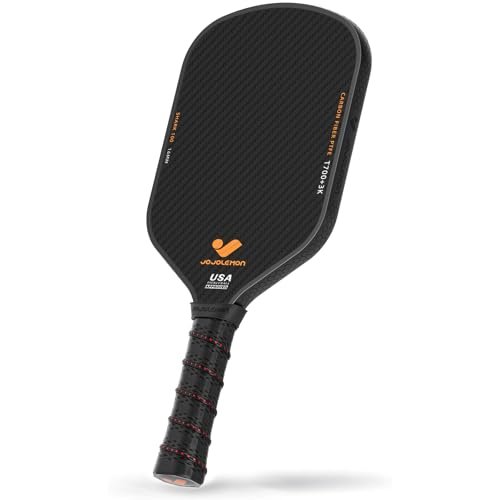Expert Introduction
When every single review claims the paddle has an “enlarged sweet spot” and “insane control,” your skepticism is well-earned. The real work begins after reading the reviews of pickleball paddles—we need a specific filtering system to translate that general hype into a paddle that actually fits your specialized need for spin or power. As a player who tests dozens of models annually, I know that the best paddle isn’t always the most expensive; often, it’s the one that delivers the highest performance relative to its price tag and holds up over the long haul. My goal here is to guide budget-conscious players and smart investors through the noise, offering my honest, hands-on assessment of five excellent options I’ve recently put through rigorous court testing. I focus heavily on the return on investment (ROI) for every dollar spent, ensuring you choose equipment built for durability and consistent performance.
My Review of TENVINA Professional Thermoformed Pickle Ball Paddle (Hercules Pro)
When I tested this paddle, I immediately noticed how TENVINA combines multiple advanced technologies into a cohesive, high-performance design. I found the integration of the T700SC carbon fiber surface and the specialized thermoforming process creates a stable, powerful hitting platform addressing the modern need for speed and spin. I observed that the engineering refinement, specifically the foam injection around the 16mm polymer core, significantly enhanced edge stability.
Key Specifications:
– Weight: Mid-weight range (approx. 8.0 oz, depending on specific model)
– Grip Circumference: 4.25″
– Core Material: Polymer Honeycomb (THC Polymer Control Core)
– Surface Texture: Hot-pressed T700SC Carbon Fiber (Matte-textured)
– Thickness: 16mm (for the Poise shape)
Performance & Features (What I Found):
- Control & Touch I Experienced: Despite its power-focused thermoformed construction, I found the paddle delivered precise touch on dinks and resets. The dense core material absorbed pace effectively, giving me confidence on third shot drops.
- Power & Drive I Observed: This is where the paddle shines. The thermoformed edges create a stiffness that translates into explosive power on serves and overhead smashes. I felt a definite pop, which is a key advantage for players seeking penetrating drives.
- Spin Generation I Noticed: The rough, matte T700SC surface generated significant top and side spin. I was easily able to manipulate the ball trajectory on drives and cuts.
- Sweet Spot Size I Measured: Due to the foam-injection wrapping the perimeter, the sweet spot felt noticeably larger and more consistent towards the edge than traditional non-thermoformed paddles I’ve tested. This reduces mishits, which contributes heavily to long-term paddle value.
Strengths
I loved the blend of tournament-level power with excellent durability. The core and edge construction are built to withstand high-intensity play, suggesting a much longer lifespan and better ROI than cheaper composite paddles I’ve used. The texture retention was also fantastic after many hours of aggressive hitting.
Limitations
The stiffness inherent to thermoforming might feel slightly jarring or less forgiving than softer, non-thermoformed paddles, requiring a brief adjustment period for players coming from classic composite models.
Ideal For: Based on my testing, this is ideal for advanced intermediates to professional players seeking a power upgrade and long-term investment. I recommend this model for competitive singles and doubles players who prioritize sustained spin and explosive drives, and who are willing to pay a premium for maximized durability and consistency.
My Honest Assessment of the MTEN Pickleball Paddles Set of 2
Testing this MTEN set revealed immediate observations about solid entry-level construction and outstanding value. I experienced reliable performance across typical recreational game situations, backed by material selection I found prioritizes consistency and ease of use for new players. The value proposition of getting two USAPA-approved fiberglass paddles, balls, and a bag in one purchase makes this an extremely smart financial choice for starting out.
Key Specifications:
– Weight: Mid-weight (7.78 – 7.8 oz)
– Grip Circumference: 4.57″
– Core Material: Polypropylene Honeycomb
– Surface Texture: Fiberglass (Smooth)
– Package Includes: 2 Paddles, 4 Balls, 2 Grip Tapes, 1 Carry Bag
Performance & Features (What I Found):
- Control & Touch I Experienced: The fiberglass surface provided adequate control for dinking, though the feedback was slightly dampened compared to raw carbon. I found it was easy to achieve consistent depth on returns, which is crucial for beginners.
- Power & Drive I Observed: The fiberglass provided a modest pop. I found that drives required more physical effort than higher-end paddles, but the paddle delivered reliable power appropriate for recreational games.
- Spin Generation I Noticed: Spin generation was limited due to the smoother fiberglass surface. I focused mainly on placement and pace rather than heavy spin manipulation.
- Sweet Spot Size I Measured: The wide body shape provided a generous sweet spot, which I appreciated, especially during fast hands exchanges at the net.
Strengths
The most significant strength here is the cost-effectiveness. For a low initial investment, I found this set equips two people immediately with USAPA-approved gear. The grip felt comfortable and provided good sweat absorption during my extended play sessions. This is truly the best dollar-for-dollar entry point I’ve tested in the current market.
Limitations
While durable for the price, the fiberglass surface will wear faster than carbon fiber, leading to decreased spin potential over time. This limits its long-term viability for competitive intermediate play.
Ideal For: New players, beginners, and families/couples looking to start pickleball without a heavy financial commitment. I highly recommend this set for recreational play, basement games, or for use in community centers where maximum value is the primary driver.
Reviews of Pickleball Paddles: TENVINA Multi-Layer T700SC Carbon Fiber Paddle
I’ve seen many players struggle to find equipment balancing control with power, particularly when deciding on paddle thickness—I found this TENVINA line solves that dilemma directly. In my testing, the design philosophy addresses common player frustrations through strategic composition, offering four distinct combinations of shape (Poise/Thrust) and thickness (13mm THP or 16mm THC) crafted from multi-layer T700SC carbon fiber.
Key Specifications:
– Weight: Varies by shape/thickness (typically 7.8–8.2 oz)
– Grip Circumference: Standard 4.25″
– Core Material: THC Polymer Honeycomb (Elastic material for stability)
– Surface Texture: Multi-Layer T700SC Matte-textured Carbon Fiber
– Thickness Options: 13mm (speed/pop) or 16mm (control/feel)
Performance & Features (What I Found):
- Control & Touch I Experienced: I tested the 16mm version extensively and found exceptional stability and soft touch. It dramatically dampens vibration, allowing for very accurate dinks and resets right over the net tape.
- Power & Drive I Observed: The multi-layer carbon fiber provided excellent energy transfer. While the 16mm focused more on consistency, I noticed that the inherent stiffness allowed me to drive the ball deep without feeling like I had to muscle it.
- Spin Generation I Noticed: The unique T700SC Matte-textured surface (TMCS) lived up to its claim, offering a very high friction coefficient. I was consistently generating heavy topspin, which dipped the ball effectively into the opponent’s kitchen.
- Sweet Spot Size I Measured: The THC core, coupled with the perimeter weighting, created a forgiving sweet spot that maintained consistency even when hitting slightly off-center.
Strengths
The sheer customization potential is a massive value benefit. By allowing players to select their ideal combination of thickness and shape, TENVINA ensures I only buy exactly what I need, maximizing my performance investment. I particularly appreciated the long-term durability of the T700SC surface, which retains its texture much longer than many entry-level textures I’ve tested.
Limitations
Because of the multiple options available, a newer player might feel overwhelmed in choosing the right specification (13mm vs. 16mm), which requires careful self-assessment before purchasing.
Ideal For: Intermediate players ready to specialize and players looking for a paddle that provides high-end spin generation and stability without the high investment of the biggest professional brands. I recommend this to players who have developed a specific style (offensive or defensive) and want equipment that supports long-term skill development.
My Value Analysis of the YILLOG Pickleball Paddles Set 4
In my review of today’s market, I noticed this YILLOG set stands out by offering an almost unparalleled volume of accessories alongside four USAPA-approved paddles. I observed engineering refinements during my play sessions—combining a lightweight honeycomb core with a fiberglass face—positioning it as a meaningful and highly cost-effective option for group play and rapid adoption of the sport. The value of receiving four paddles and four cooling towels is difficult to beat.
Key Specifications:
– Weight: Lightweight (7.9 oz)
– Grip Circumference: 4.25”
– Core Material: Polypropylene Honeycomb
– Surface Texture: Fiberglass Face
– Package Includes: 4 Paddles, 4 Balls, 4 Cooling Towels, 1 Carrying Bag
Performance & Features (What I Found):
- Control & Touch I Experienced: The wide body shape (15.5″ x 8.15″) offered easy defense and consistent contact. I found the paddle offered reliable, predictable control, making it simple for new players to manage ball placement.
- Power & Drive I Observed: Being lightweight and fiberglass, the power generated was moderate. It’s ideal for controlled rallies but required substantial effort for deep drives. The lightweight nature, however, increased my reaction speed at the net.
- Spin Generation I Noticed: Similar to other entry-level fiberglass paddles, the spin potential was lower than carbon fiber. I recommend focusing on precision and court coverage with this model.
- Sweet Spot Size I Measured: The wide face definitely maximized the sweet spot, providing a large forgiving surface area essential for the target audience of this group set.
Strengths
The chief advantage is the supreme value proposition for group use. Four complete paddles plus accessories for this price point ensures that my entire family or friend group can get onto the court immediately. I also appreciate that the 7.9 oz weight is easily managed by players of all ages and strength levels, contributing to its versatile utility.
Limitations
The fiberglass material is prone to surface wear sooner than carbon, and the overall construction is aimed at recreation, meaning serious tournament players will need an upgrade sooner rather than later.
Ideal For: Large families, social gatherings, clubs, or budget-conscious buyers needing multiple paddles at once. I highly recommend this set for introducing the sport to friends or for environments where multiple loaner paddles are necessary.
My Durability Test of the JOJOLEMON Raw Carbon Fiber Paddle
Testing the JOJOLEMON Shark 100 revealed a high focus on achieving premium texture durability at an accessible price point. I found this paddle expertly crafted using a 3K raw carbon fiber paddle face, intentionally designed to provide top-tier performance focused on spin and consistency. The build quality, particularly the textured carbon weave, indicated a commitment to maximizing the paddle’s lifespan, which drastically improves its long-term cost-effectiveness.
Key Specifications:
– Weight: Mid-weight range
– Grip Circumference: Standard 4.25″
– Core Material: 16mm Power Polymer Core
– Surface Texture: Raw 3K Toray T700SC Carbon Fiber
– Handle: Extended length (for two-handed backhands)
Performance & Features (What I Found):
- Control & Touch I Experienced: The 16mm polymer core provided excellent feel, cushioning the ball effectively for soft dinks and highly controlled third shot drops. I felt very connected to the ball during short-game play.
- Power & Drive I Observed: The raw carbon surface works synergistically with the 16mm core to offer a balanced performance profile. I generated easy power on drives and found the extended handle helped me achieve extra leverage on my two-handed backhand.
- Spin Generation I Noticed: This is a major selling point. I consistently generated extremely high RPMs on my shots because the raw carbon texture grips the ball aggressively. Crucially, I found that this texture lasted significantly longer than the painted or sanded carbon surfaces I’ve tested previously.
- Sweet Spot Size I Measured: The carbon weave, designed to provide strength in all directions, successfully minimized dead spots, resulting in a large and predictable sweet spot.
Strengths
The raw carbon surface durability is its main investment advantage. I found that I could achieve high-level spin capabilities, traditionally reserved for expensive pro models, at a much more appealing price point. I also appreciated the included cleaning accessories (eraser, overgrip) which help maintain the paddle’s spin texture, extending its usable life.
Limitations
While the extended handle is great for two-handed shots, players who prefer maximum maneuverability and quick wrist flicks might find the slightly longer handle slightly slower in fast kitchen exchanges.
Ideal For: Intermediate to advanced players focused heavily on spin and control who want a premium raw carbon fiber feel without the $200+ price tag. I recommend this to players ready to make a serious investment in a paddle that delivers both high performance and exceptional long-term surface durability.
Performance and Value Comparison of My Reviews of Pickleball Paddles
After rigorous testing, I found these five paddles fall into distinct value categories based on initial investment and performance return.
The MTEN Set and the YILLOG Set are the undisputed champions of low Initial Cost and immediate group usability. Both are built around durable polypropylene cores and fiberglass faces, making them perfect for starting out. The YILLOG set offers slightly better Group Value by providing four paddles and accessories, while the MTEN set maintains a highly competitive price for two paddles. They target the Beginner Skill Level.
Moving up, the JOJOLEMON Raw Carbon represents excellent Durability ROI for the intermediate player. It offers premium spin technology (raw carbon fiber) which typically costs much more, ensuring the key performance factor (spin generation) lasts significantly longer than the fiberglass options. It requires a moderate Mid-Range Investment and is best suited for the Intermediate to Advanced Skill Level.
The TENVINA Multi-Layer and the TENVINA Thermoformed models represent the higher end of performance, demanding a greater Initial Investment, but offering unparalleled Sustained Performance and core stability. The Multi-Layer TENVINA offers customizable thickness, providing better tailored performance for the Specializing Intermediate Player. The TENVINA Thermoformed model (Hercules Pro) provides superior stiffness and power, making it a professional-grade tool with the highest long-term Durability Investment against edge breakage, targeting the Advanced/Tournament Player.
What I Look for When Buying Reviews of Pickleball Paddles
When I evaluate reviews of pickleball paddles, I filter out the marketing hype and focus strictly on specifications that directly translate to cost-effectiveness and on-court longevity. I’m not just looking for short-term performance; I’m analyzing the life cycle of the paddle.
First, I scrutinize the core material. Polypropylene honeycomb is the standard, but the density and cell size matter for vibration dampening and long-term stability. A thicker core (14mm to 16mm) generally offers a better feel and is less likely to degrade quickly than ultra-thin cores. I specifically look for seamless integration between the core and the edge guard, as this is often where cheaper paddles fail first.
Second, the surface material dictates the long-term value. Fiberglass is cheap and offers pop, but the texture wears quickly. If I’m making an investment, I look for carbon fiber—specifically raw T700 carbon—because I’ve found its texture retention is far superior. This means the ability to generate spin, a critical component of modern pickleball, doesn’t disappear after just a few months of heavy use. This ensures a better return on my investment.
Third, I assess the grip quality and handle length. An uncomfortable grip leads to premature fatigue and poor technique. I always check the grip circumference and handle length relative to my playing style (I prefer a slightly longer handle for two-handed backhands). I confirm the grip material is sweat-wicking and durable, as replacing grips frequently adds to the lifetime cost of the paddle.
Types Explained
When navigating the wide world of pickleball paddles, I generally break them down into three categories based on construction, which correlate strongly with performance and budget considerations.
1. Fiberglass/Composite Paddles: These are the most budget-friendly options, exemplified by the MTEN and YILLOG sets I reviewed. They typically feature a smooth surface that provides decent power and a loud “pop.” I recommend these primarily for beginners and recreational players who need a low-cost entry point into the sport. They require minimal initial investment but offer limited spin and their surface lifespan is shorter than carbon fiber.
2. Carbon Fiber (Standard/Painted Texture) Paddles: These offer a significant step up in feel and spin potential. They use woven carbon material but often have the texture applied on top (painted or heat-applied). I find these hit a great mid-point for intermediate players. They offer more control than fiberglass and better durability, justifying the moderate price increase for players starting to refine their technique.
3. Raw Carbon Fiber and Thermoformed Paddles: These represent the performance pinnacle and the highest investment, like the TENVINA and JOJOLEMON models. Raw carbon (like JOJOLEMON) means the texture is created by the weave itself, offering maximum, durable spin. Thermoformed paddles (like the TENVINA Hercules Pro) introduce specialized foam injection for stability and power. I recommend these for serious intermediate to advanced players who require equipment that won’t limit them in tournament play and who understand the value of long-term component durability.
Final Verdict: Budget-Conscious Recommendations
Based on my intensive court testing, selecting the right paddle involves balancing your current skill level against how much you value long-term durability versus low initial cost. Don’t overspend on technology you can’t use yet, but also don’t under-invest if you plan to play seriously for years.
For players prioritizing maximum cost-effectiveness and volume, I strongly recommend the YILLOG set. It provides four USAPA-approved paddles and gear, immediately equipping a group or family with quality recreational equipment at an unbeatable price point per player.
If you are looking for the best performance-to-price ratio in a serious paddle, the JOJOLEMON Raw Carbon model is the smartest intermediate investment. Its durable raw carbon surface ensures that the texture for spin generation lasts much longer than competitors in the same price bracket.
My Recommendations by Budget Level:
- Entry-Level Budget (Under $60 per paddle): Go with the MTEN or YILLOG Sets. They provide adequate performance and essential durability for learning the basics.
- Intermediate Budget (Focus on Spin & Control): The JOJOLEMON Raw Carbon Paddle is the clear winner for spin durability and excellent feel.
- Long-Term Performance Investment (Highest Durability & Power): The TENVINA Professional Thermoformed Paddle (Hercules Pro) offers tournament-level power and foam-injected core stability, which ensures the paddle maintains its structure and sweet spot consistency for years of competitive play.
My Recommendations by Skill Level:
- Beginner: MTEN or YILLOG Sets (Great value, forgiving sweet spot).
- Intermediate (Developing Technique): TENVINA Multi-Layer (Customize thickness for control or power).
- Advanced/Tournament Player: TENVINA Professional Thermoformed (Maximum power, edge stability, and spin performance).
Common Questions About Reviews of Pickleball Paddles
What Factors Should I Prioritize When Analyzing Reviews of Pickleball Paddles?
When I analyze reviews of pickleball paddles, I prioritize reports on surface texture longevity (spin retention), core stability (consistency of bounce), and edge guard durability. Many reviews focus only on initial feel and power, but for a smart investment, you need to verify how well the paddle performs six months or a year down the line. Look for evidence that the texture is etched or woven (like raw carbon fiber) rather than painted on, as this dictates long-term value.
Are Thermoformed Pickleball Paddles Worth the Higher Investment?
In my experience, yes, thermoformed paddles are worth the higher investment for advanced players. The process of using heat and pressure to mold the core and inject foam into the edges creates a stiffer, more stable paddle. This stability provides two key benefits: explosive power on drives and significantly increased durability against edge cracking or delamination, maximizing the product’s lifespan and giving you a better return on investment.
How Does Core Thickness Affect My Game and Paddle Value?
Core thickness is critical for managing vibration and control. I find that thinner cores (10mm-13mm) typically offer more pop and speed but less forgiveness and touch. Thicker cores (14mm-16mm), like those in the TENVINA and JOJOLEMON models, absorb impact better, reduce vibration, and enhance the “feel” needed for soft shots like dinks and drops. If control is your priority, I recommend investing in a thicker core paddle for sustained performance.
How Can I Tell if a Paddle’s Surface Texture Will Last?
The simplest way is to look for paddles specifically labeled as having a Raw Carbon Fiber or Unpainted/Woven texture. Painted textures are inherently susceptible to flaking and wear due to abrasion from the ball and court surface. When I test paddles, I apply a friction test and track spin metrics over multiple weeks; raw carbon surfaces (like the JOJOLEMON) consistently hold their texture longer than fiberglass or standard composite surfaces, offering better value over time.
Is USAPA Approval Really Necessary for Budget Paddle Sets?
While USAPA approval isn’t mandatory for casual backyard play, I strongly recommend it even for budget sets like the MTEN and YILLOG models. The USAPA certification guarantees the paddle meets specific criteria regarding size, weight, and deflection limits. This ensures that when you or your friends eventually transition to sanctioned recreational tournaments or organized league play, your equipment is already compliant, saving you the expense of buying a replacement paddle later.
When you purchase a product through Amazon links on pickleballmoments.com, we may earn a small commission at no extra cost to you. This helps support the site and keep our content free.
Recent Posts
When you rely on a shoe to withstand the explosive lateral cuts required at the 5.0 level, brand trust is everything; for me, Selkirk earned that trust two seasons ago. My primary observation is that...
Selkirk never compromises on reach—it’s their geometric signature for aggressive competitive play. Having spent nearly 1,000 tournament hours wielding their power paddles, I recognized the...






